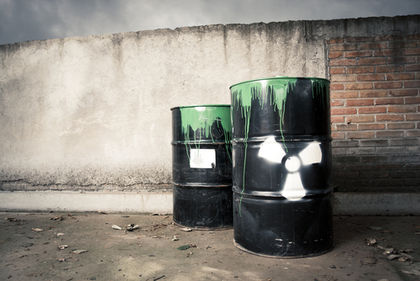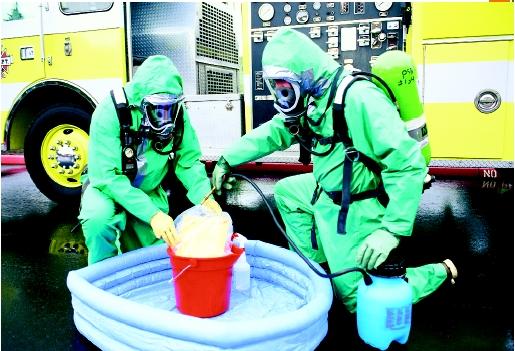Hazardous Waste

The Resource Conservation and Recovery Act (RCRA), enacted in 1976, defines hazardous waste as a liquid, solid, sludge, or containerized gas waste substance that due to its quantity, concentration, or chemical properties may cause significant threats to human health or the environment if managed improperly. U.S. legislation considers a waste hazardous if it is corrosive, flammable, unstable, or toxic. Sources of hazardous waste may include industry, research, medical, household, chemical producers, agriculture, and mining, as well as many others.
Most hazardous waste comes from industrial sources. The EPA specifies four different categories of hazardous waste that are subject to regulation: hazardous wastes from nonspecific sources involved in industrial processes such as spent halogenated solvents; hazardous wastes from specific industrial sources, such as untreated wastewater from the production of the herbicide 2,4-dichlorophenoxyacetic acid (2,4,-d); commercial chemical products that may be discarded (such as benzene) used in the manufacture of drugs, detergents, lubricants, dyes and pesticides; and wastes that are classified as toxic, such as vinyl chloride. Hazardous waste from many industrial processes include solvents such as methylene chloride, a probable carcinogen that is commonly used in paint removers. Trichloroethylene, a solvent that has been found in groundwater is monitored and regulated in drinking water in the United States. Drinking or breathing high levels of trichloroethylene can lead to damage of the liver, lung, and nervous system. In many industries the sludge remaining after treatment of wastewater accounts for much of the generated hazardous waste. Sludges and wastewater from electroplating operations commonly contain cadmium, copper, lead, and nickel. These heavy metals are found in the sediment of Lake Huron and have been associated with degradation of benthos and planktonic communities. Heavy metals can impact the health of humans and wildlife in a variety of ways: lead interferes with the nervous system and can lead to learning disabilities in children and cadmium accumulates in humans and animals and can lead to kidney disfunction. Household products that contain hazardous ingredients are not regulated under RCRA but should be disposed of separately from municipal garbage following label instructions. Household hazardous waste (HHW) can include used motor oil, paint thinners and removers, wood preservers, batteries, fluorescent lights that contain mercury, and unused pesticides.
The U.S. Environmental Protection Agency (EPA) and state regulatory agencies collect information about the generation, management, and final disposal of hazardous wastes regulated under RCRA. This report gives detailed data on hazardous waste generation and waste management practices for treatment, storage, and disposal facilities.
Waste Minimization and Recycling
Recycling and waste minimization may be the best ways to deal with hazardous waste. Waste minimization reduces the volume of waste generated, whereas recycling means that less hazardous waste requires disposal. Techniques for waste minimization may include audits, better inventory management, production process/equipment modifications, and operational/maintenance procedures. Raw material changes, volume reductions, nonhazardous material substitutions, reuse, or recovery also reduce hazardous waste production. For example biodegradable, nontoxic lactate esters are solvents manufactured from renewable carbohydrate sources that can be substituted for toxic halogenated solvents.
The EPA's Industrial Toxics Project is a nonregulatory program initiated in 1990 to achieve, voluntarily, overall reductions for seventeen toxic chemicals reported in the government's Toxics Release Inventory (TRI), including cadmium, lead, mercury, trichloroethylene, and toluene. The recycling of waste through waste exchanges is one aspect of industrial ecology and another way to address the issue of hazardous waste disposal. For example the sludge that accumulates in scrubbers removing sulfur dioxide from power plant smokestacks contains calcium sulfate, which can be recycled in wallboard. Waste exchange also promotes the use of one company's waste as another company's raw material. Waste exchanges typically list both available and desired materials. Several regional waste exchanges exist, as well as exchanges within small geographic regions. Some exchanges charge for their services, whereas others are supported by grants.
Disposal Options and Problems
Disposal options for hazardous waste include landfills, injection wells , incineration, and bioremediation , as well as several others. The greatest concern with the disposal of hazardous waste in landfills or injection wells is that toxic substances will leak into surrounding groundwater. Groundwater is a major source of drinking water worldwide and once it is contaminated, pollutants are extremely difficult and costly to remove. In some instances, it is impossible to remove groundwater contamination. The ideal disposal method is the destruction and conversion of hazardous waste to a non-hazardous form. New technology for hazardous and mixed low-level radioactive waste conversion includes a high-temperature plasma torch that converts low-level radioactive wastes to environmentally safe glass. Conversion to

The most common form of hazardous waste disposal in the United States is landfilling. Hazardous waste landfills are highly regulated and are required to include clay liners, monitoring wells, and groundwater barriers. The 1984 Hazardous Solid Waste Amendments require the monitoring of groundwater near landfills for thirty years. Injection wells may be used to inject hazardous waste deep into the earth, but problems result with aquifer contamination and the ultimate fate of the hazardous waste after injection is unknown.
Incineration may be an effective way to convert hazardous waste into a nonhazardous form while greatly decreasing its volume. The waste is burned and converted into carbon dioxide, water, and inorganic by-products. The problems associated with incineration are high capital and operating costs, and the disposal of ash, which may contain hazardous substances. In addition, incinerating wastes can cause mercury and dioxin air pollution. Bioremediation may also be used in situ or ex situ to convert hazardous wastes to nontoxic by-products using microorganisms and natural degradation processes. Biodegradation requires very long treatment times and it may be difficult to control or enhance natural degradation processes. Phytoremediation, the process by which plants absorb and in some cases degrade hazardous substances in the environment, is being investigated as an emerging cleanup technology. For example poplar trees have been shown to break down the herbicide atrazine, mustard plants will remove lead from soil, and the alpine pennycress plant will take large amounts of heavy metals and also uranium from soil.
When hazardous waste is to be transported off-site for disposal, the waste generator prepares a shipping document called a manifest. This form must accompany the waste to its final destination and is used to track the waste's movements from "cradle to grave."
Hazardous Waste Production in the United States
Facilities that produce hazardous waste, usually as a result of an industrial process, are considered large-quantity generators (LQG) or small-quantity generators (SQG) depending on the quantities produced. Hazardous waste may be transported to alternate locations to be treated, stored, or disposed of, or may be managed at the place of generation.
In 1995, 20,873 LQGs produced 214 million tons of hazardous waste regulated by RCRA. There were 3,489 fewer LQGs and a reduction of 44 million tons of waste by 1995 compared to 1993. The five states generating the largest amount of hazardous waste were Texas (69 million tons), Tennessee (39 million tons), Louisiana (17 million tons), Michigan (13 million tons), and Illinois (13 million tons), accounting for 70 percent of the national totals.
The industrial trade of hazardous waste has become an extensive problem. Many third world countries accept large volumes of hazardous waste for disposal in return for sizable financial compensation. Unfortunately, the large profits reaped by such poor countries do not compensate for the long-term environmental impacts from improperly managed hazardous waste. Many wastes have also been dumped illegally on international shores where environmental regulation and controls are often lacking.
SEE ALSO A BATEMENT ; B ROWNFIELD ; C LEANUP ; G REEN C HEMISTRY ; I NCINERATION ; I NDUSTRIAL E COLOGY ; I NJECTION W ELL ; L ANDFILL ; M EDICAL W ASTE ; R ADIOACTIVE W ASTE ; R ESOURCE C ONSERVATION AND R ECOVERY A CT ; W ASTE , T RANSPORTATION OF .
Bibliography
Davis, Mackenzie L., and Cornwell, David A. (1998). Introduction to Environmental Engineering. Boston: McGraw-Hill.
Graedel, T.E., and Allenby, B.R. (1995). Industrial Ecology. Upper Saddle River, NJ: Prentice Hall.
La Grega, Michael D.; Buckingham, Philip L.; Evans, Jeffrey C.; and Environmental Resources Management. (2001). Hazardous Waste Management. Boston: McGraw-Hill.
Vesiland, P. Aarne; Worrell, William; and Reinhart, Debra. (2002). Solid Waste Engineering. Australia: Brooks/Cole.
Watts, Richard J. (1998). Hazardous Wastes: Sources, Pathways, Receptors. New York: John Wiley & Sons.
Margrit von Braun and Deena Lilya
Comment about this article, ask questions, or add new information about this topic: